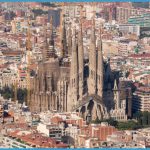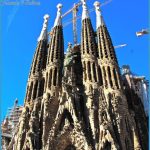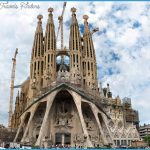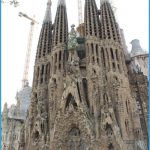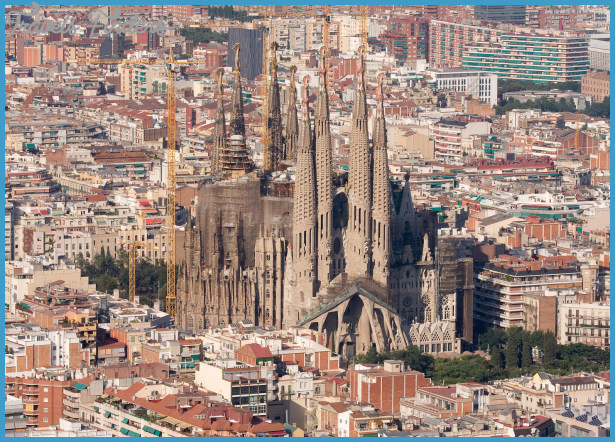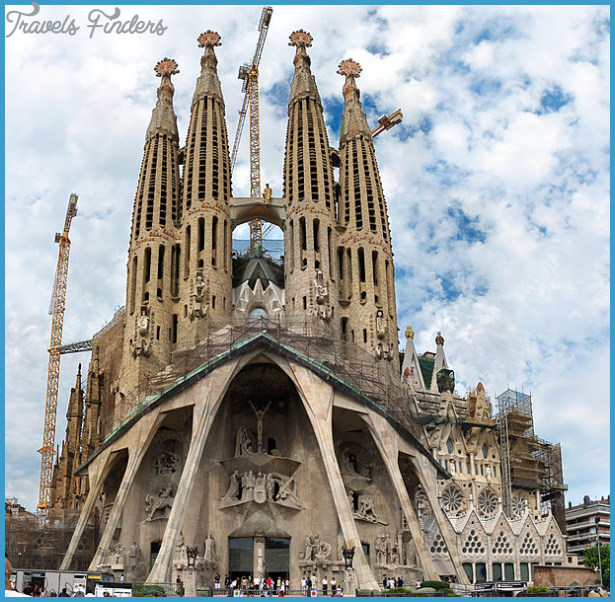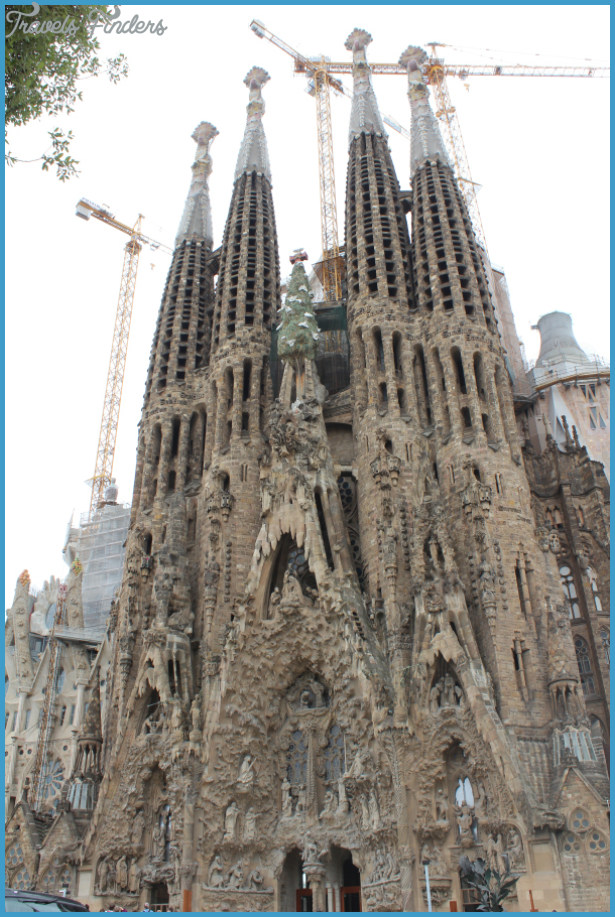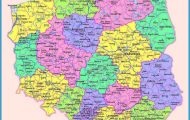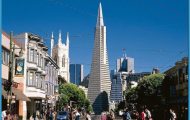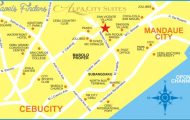ANTONI GAUDI
The Expiatory Church of the Holy Family, Barcelona, usually known as the Sagrada Familia (Holy Family), is the masterwork of Antoni Gaudl, the great Catalan architect. Gaudl spent the last 40 years of his life on the project, designing the church in a very personal blend of Gothic and the Art Nouveau style that was fashionable in the late 19th century. When he died, however, only a small part of the enormous church had been completed. Since then, building work has continued, largely based on Gaudl’s design, but with major interruptions at various stages, notably during the Spanish Civil War, which lasted from 1936 to 1939. Some parts of the church, however, had to be planned from scratch, because Gaudl did not leave detailed plans of every feature. Although it has still not been finished, the resulting building is a staggering achievement-a cluster of strange, elongated spires topped with colored finials, an idiosyncratic assortment of pointed gables and roofs above Gothic-style windows, and a mass of sculpture. It is a church on a vast scale, in a style unlike any other, with a totally original handling of space, form, structure, and decoration.
Like many churches, the Sagrada Familia is based on a cruciform plan with an apse (curved end) housing the high altar, but Gaudl modified the layout by incorporating numerous treelike columns as well as vaults and walls that curve and divide in an unusual manner. Churches have often been likened to forests, but never has this comparison been so apt as at the Sagrada Familia. Other imaginative details-from pinnacles that resemble seed pods and honeycomb patterns on the walls to the organic twists and turns of the carvings-are based on plant designs.
The church’s slender spires, emphasized by the pattern of openings and carvings that extend from top to bottom, create a striking profile as they rise majestically above the center of Barcelona. Eighteen spires are planned in total-twelve representing the Apostles, four the Evangelists, and one each for Jesus and Mary. The church’s sculpted fagades are also outstanding. They look Gothic at first, but the sloping columns, bizarre canopies, and carved figures make them seem to distort and change before your eyes.
Decoratively, the building is typical of its creator. Gaudl loved bright colors, and although much of the church is finished in natural stone, the tops of the spires are covered with the mosaics made from ceramic tiles that Gaudl used so widely on his secular buildings. Inside the church, color is provided not just by stained glass, but also by colored light fittings that twinkle from the high vaults. Some critics have found this decorative exuberance lacking in taste, but many of the details have symbolic significance. Crowning the Nativity fagade, for example, is a large sculpted cypress, an evergreen tree that represents everlasting life. Its leaves are green, and its branches are festooned with white alabaster doves that represent the souls of the faithful entering Heaven. This Tree of Life is topped with symbols of the Holy Trinity. Gaudl’s inspired use of decoration and his architecture as a whole reflect an artist single-mindedly committed to a very personal vision-a vision that Gaudl’s successors in the 20th and 21st centuries have done their best to realize.
ANTONI GAUDl
1852-1926
The son of a coppersmith, Antoni Gaudl i Cornet was born at Reus, Tarragona, Spain, and began an apprenticeship at a mill before studying architecture in Barcelona. Although interested initially in revival movements and the works of art critics such as John Ruskin, Gaudl grew up at a time when artists in Catalonia were seeking a way to express their nationalism, and he became an exponent of Catalan modernism, in which ideas from the past (including the Moorish and Gothic styles) were fused with more recent influences, such as Art Nouveau, to forge a distinctive style.
Most of Gaudi’s buildings are in Barcelona.
The Casa Mila and Casa Batllo are city apartment blocks with curving walls, and he designed lavish private houses, such as the Palacio Guell (for his patron Don Basilio Guell), where he developed his signature forms parabolic arches and eccentric roofscapes. In these buildings Gaudl translated the decorative curves of Art Nouveau into architecture. He also designed the Park Guell, a remarkable landscape on a hill above Barcelona, its structures studded with his trademark mosaics. After 1882 Gaudl spent most of his time on the Sagrada Familia, a building that gave him unique scope to be inventive, and the one with which his name will always be most closely associated.
Visual tour: exterior
1 FINIALS Natural stone is often left exposed on church exteriors. At the Sagrada Familia, however, the spires terminate in a riot of applied color that picks out carved symbols, such as the cross and the bishop’s ring, and words of prayer and praise, such as excelsis. The spires’ twisted, multifaceted forms catch the sun as it moves across the sky, picking out splashes of red, gold, white, and green. The finials are covered with mosaics made from broken tiles favored by Gaudl because the color of the ceramics was tough and permanent, fading less with the passing of time than paint.
1 PASSION FACADE The north entrance of the church is through a portal in the Passion fagade, a vast wall topped by four spires and adorned with sculptures depicting the Passion of Christ, from the Last Supper to his Crucifixion and entombment. This part of the church was built in the late 20th century, but the overall layout is based on Gaudi’s design. An enormous sloping canopy protects the entrance, its overhanging roof supported on a series of bizarrely angled columns whose form resembles that of giant bones or branches. To support the carvings, Gaudl designed a series of stone platforms that seem to emerge organically from the walls. In 1989 the Catalan sculptor Josep Maria Subirachs began work on the figures that adorn the platforms.
1 PASSION SCULPTURES Working more than 100 years after Gaud! began the building, Josep Maria Subirachs sculpts in a bold, dramatic style. His figures, such as that of Nicodemus seen here anointing Christ’s body, are almost cubist in form, often with angular heads and multifaceted limbs. The sculptures are very different from those Gaud! envisioned and have provoked controversy, but many visitors find them powerful.
ON CONSTRUCTION
1 LETTERING There are sacred writings and words on many of the walls of the Sagrada Familia, acknowledging the importance to Christians of the word of God and the text of the Bible. Some of these inscriptions are in a flowing, organic Art Nouveau style evolved by Gaudi, while others are more recent. The inscriptions on the bronze portals of the Passion fagade twin doors that open like a book are among the latter. These are the work of the sculptor Subirachs, and contain texts from the Gospels in capital letters wedged closely together. Most of the words on the doors are finished quite roughly, their surfaces broken up by numerous horizontal striations. Important words or phrases, such as the name of Jesus (above), are beautifully polished to make them stand out from the others.
Work is still continuing on the Sagrada Familia. In Gaudi’s lifetime many thought that the complex church would take centuries to build, but a completion date of the late 2020s is now expected. The drawing on the right shows what the final church will look like. To complete the building’s 18 spires and the Glory fagade, where the entrance to the nave will be, the architects and builders have had to rely on diverse sources. Some of Gaudi’s original plans have not survived, so architects have had to work out the missing details, using computers to help model Gaudi’s unusual shapes and forms. Fortunately, some of the models made in Gaudi’s time still exist, and these have enabled builders to construct the roofs and other incomplete parts of the church.
1 NATIVITY FACADE Located on the south side of the church, this was the first fagade to be completed. Although not painted in bright colors as the architect originally intended, it is built according to Gaudi’s wishes, with swirls of sculpture rising above a trio of portals. The carvings show the birth and early life of Jesus and include groups of singing and trumpeting angels. A wealth of incidental detail covers the surface of the complex fagade, including crosses, rosaries, plants, birds, animals, and even the carpentry tools of Joseph’s workshop.
2 NAVE When working with traditional Gothic forms, such as this rose window, Gaudi simplified them to emphasize their sculptural qualities. All intricate medieval tracery has been eliminated from this nave window to leave 12 plain, glazed openings and a central roundel. This simplicity provides the backdrop for a more complex treatment of the stonework.
Visual tour: interior
3 NAVE COLUMNS Gaudi’s columns are unique in the history of architecture because they change shape as they ascend they are fluted at the base and smooth-sided higher up, and the polygonal cross section becomes circular. The columns branch out like trees toward the top to form clusters of slender branches that support different parts of the vault. In the nave, where the columns are most numerous, they form a spectacular forest of uprights and diagonals, with strange multifaceted capitals and swellings or knots where the uprights divide.
1 STAINED-GLASS WINDOW The artist Joan Vila-Grau has been working on the stained-glass windows for the Sagrada Familia since 1999, following the general plan outlined by Gaudl. Using abstract patterns of saturated color, Vila-Grau creates the vivid light that suffuses the interior. The glass is made in the workshop of Josep Maria Bonet, whose work for the church dates back to the time when the crypt windows were glazed.
1 CROSSING At the
heart of the building is the crossing. Here, the nave and sanctuary, which form the main north-south axis of the church, meet the transepts, which extend from east to west. The nave, to the right, is longer and wider than the other arms, with two pairs of side aisles, while the sanctuary and transepts have one aisle on each side. All these spaces are vaulted, and the upward-sweeping lines of the columns draw your eye toward the patterns of light in the stone vaults. The church interior is vast and held around 6,500 people during the consecration ceremony of the church in 2010.
2 VAULT DETAIL The columns divide at the top to support a series of concave compartments in the vaults, each of which has a circle in the center containing a light fitting. Although influenced in part by the stone vaults of medieval cathedrals, the design of these compartments, is unusual. Unlike the linear ribs of medieval vaulting, there are jagged edges where each compartment adjoins the others, creating the effect of a series of starbursts.
The curves of the vaults reflect the light from above, illuminating the interior of the church. These vaults are also reminiscent of the leafy crowns of trees a reference to the natural world that was such a great source of inspiration to Gaudi.
1 GALLERIES High galleries, sometimes used to accommodate choirs, line the church’s interior and are reached via spiral staircases that run up the walls. These narrow galleries have undulating stonework, and the undersides are carved in a scalloped form to harmonize with the leaflike vaults above them.
1 APSE The east end (in the liturgical sense) of the church is the part of the building most similar to a medieval church. The space is curved in shape, like the apse of a Gothic cathedral. The radiating series of high windows and the semicircle of seven small chapels are also Gothic features. There are two main reasons for the strong Gothic influence here. Firstly, Gaudi had to follow the lines of the crypt, which had been built in the Gothic revival style before he joined the project. Secondly, the apse was the first part of the church to be built above ground, and Gaudi had not yet developed his later idiosyncratic style.
1 TOWERS The tapering towers of Gaudi’s masterpiece are just as striking within as from outside. Long vertical protrusions in the stonework similar to pilasters in conventional buildings run all the way up the inner walls of the towers, drawing your eye upward and emphasizing their immense height.

